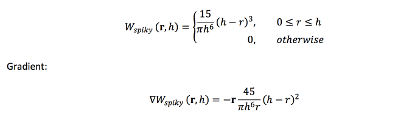Hi am currently breaking down a paper called "Position Based Fluid" and have trouble understanding some symbols.
First off, i dont have any math professional backgrounds at all - i barely understand the basics to break down some formulas but if these gets too complex and i dont have any chance to convert this code.
There is a kernel function for calculation a approximation value based on the difference between two particles - called smoothing function which does some magic math stuff behind, like transforming the distance between two particles into the range of the kernel h with some smoothing...
There are two variants of this formula, one normal and one for gradient:


What are the differerence between those?
I know that  means "Change in" and i also found out that the flipped symbol
means "Change in" and i also found out that the flipped symbol  means gradient but i have no clue what this are.
means gradient but i have no clue what this are.
Please help me to break this down.
Thanks and regards,
Final









